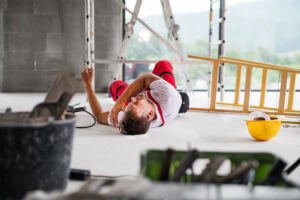 Of all job-related accidents, falls are the leading cause of serious injuries and fatalities, and it is only getting worse.
Of all job-related accidents, falls are the leading cause of serious injuries and fatalities, and it is only getting worse.
According to the Bureau of Labor Statistics’ most recent data, nearly 900 workers died in falls in 2017. This is the highest number of job-related fatalities since the U.S. began tracking these types of accidents almost three decades ago. Deaths from falls accounted for more than 17 percent of all job-related fatalities that year. Specifically in construction, the rate is even higher – at almost 40 percent.
Recent Job-Related Falls
Scott Earnest, deputy director at the National Institute for Occupational Safety and Health (NIOSH), says that falls are the number one killer for workers.
Falls continue to occur despite federal prevention efforts. Earlier this month, a 20-year stagehand veteran working at a concert venue in California fell from a roof and died from his injuries. Just a month prior, a construction worker in Kansas City fell 18 stories while doing drywall, while another construction worker in New Jersey died after falling 30 to 40 feet off a building.
In February of 2019, OSHA cited the Tarheel Corporation, a roofing contractor, for three separate violations. These violations involved not meeting fall protection requirements and came six months after an employee of the company slipped and fell to his death after working on the roof of a condo in South Florida.
Standards in Place for Fall Protection
Job-related falls from roofs, scaffolds, ladders and other elevated surfaces are preventable. Both the Occupational Safety and Health Administration (OSHA) and NIOSH, a federal research agency that focuses on worker health and safety, have attempted to address this problem by launching an aggressive public awareness campaign.
Since 2012, OSHA has partnered with other federal agencies to raise awareness among employers and employees about common fall hazards and the safety equipment and gear needed to prevent falls on the job. Nearly one million workers received fall-safety training in 2018. However, despite these efforts, safety regulations will only be effective when they are properly and routinely enforced.
Health and safety experts, including Chris Cain, the executive director for the Center for Construction Research and Training, are also concerned that smaller companies, especially those in construction, are not receiving the fall-prevention information they need. Between 2011 and 2015, less than one-third of construction workers were employed by companies with less than 10 employees. This group accounted for more than 60 percent of fall deaths in the construction industry. This could mean companies with a smaller number of employees do not have adequate safety and health programs in place to help prevent job-related falls.
While OSHA standards for fall protection and prevention vary from industry to industry, worker safety advocates believe that more needs to be done to educate big and small companies on fall-related hazards that occur in the workplace.
This includes OSHA holding employers more accountable for their actions, including stricter penalties for serious violations, especially when there is a repeated pattern of exposing workers to fall hazards.
Our Team is Ready to Help If You Have Been Injured
If you have been injured in a workplace accident, you need an experienced attorney on your side. The Harrisburg workers’ compensation lawyers at Schmidt Kramer are well-versed in federal and state laws affecting injured workers in construction accidents and in other hazardous industries. We have helped Pennsylvania workers obtain the justice and compensation they deserve.
Your legal consultation with our firm is free and you will not be charged for our services unless you receive adequate compensation for your case.
Fill out our Free Case Review form or call (717) 888-8888 to find out how we can help you.

